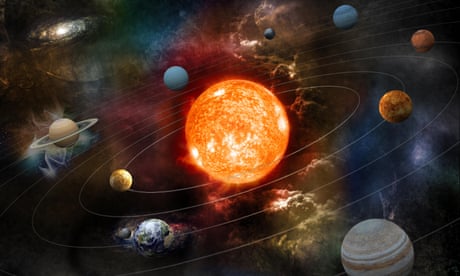- by foxnews
- 04 Mar 2025
All planets in the solar system visible in night sky at same time on Wednesday
All planets in the solar system visible in night sky at same time on Wednesday
- by theguardian
- 29 Dec 2022
- in news

Every planet in the solar system was visible in the night sky simultaneously on Wednesday, which is regarded by experts as a rare astronomical event.
Venus, Mercury, Saturn, Jupiter and Mars could all be seen in that order in the northern hemisphere with the naked eye, starting from the south-western horizon and moving east.
Uranus, located between Mars and Jupiter, and Neptune, which is between Saturn and Jupiter, can be seen with binoculars or a telescope until the end of the year.
The planets can be spotted low in the west, with the clearest view expected to be about 30 minutes after sunset, with Venus disappearing about 40 minutes later, each day until the end of the year.
Mercury is the most difficult planet to see without magnification, as it is sitting in a bright part of the sky. However, it can be spotted close to the much brighter Venus.
The rest of the planets line up eastwards, with Jupiter appearing brighter than all of the stars and high in the southern sky.
Jupiter was not expected to be visible at around midnight. However, Mars was set to be visible all night after it rose in the east just before sunset on Wednesday, and will appear red and brighter than most stars.
Saturn, the second biggest planet, will be a golden colour when it appears in the south-west after darkness falls each day until 2023. It set at about 2000 GMT on Wednesday, while the moon was expected to appear as a crescent between Jupiter and Saturn.
The last time all of the planets were visible in the sky simultaneously was in June.
Another significant event for astronomers is the Quadrantids meteor shower, which is expected to peak around 3 January, and is known for producing blue meteors travelling at 40km (25 miles) a second and occasional bright fireballs.
- by travelandtourworld
- descember 09, 2016
Rome's Exclusive Nightlife The Ultimate Guide to Luxury Prestige and VIP Experiences
Rome, the Eternal City, is celebrated for its awe-inspiring architecture, deep-rooted history, and electrifying nightlife. As twilight descends over the Colosseum and the city’s cobblestone streets begin to pulse with energy, discerning travelers and locals alike seek out the most exclusive experiences the city has to offer. From high-end rooftop lounges and private clubs to bespoke luxury gatherings, Rome’s nightlife is a refined blend of sophistication and indulgence.
read more


